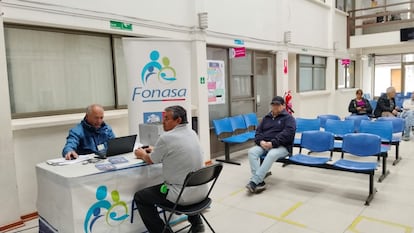Fonasa Complementary Coverage Modality: less freedom in health

Articles that are strictly opinion-based and that respond to the author's own style. These opinion pieces must be based on verified data and be respectful of people, even if their actions are criticized. All opinion columns by people not working for the EL PAÍS editorial team will carry, after the last line, a byline —however well-known the author may be— indicating the position, title, political affiliation (if applicable) or main occupation, or the one that is or was related to the topic addressed.

Fonasa 's Complementary Coverage Modality (MCC) is an imminent reality for Chileans. In fact, a massive migration of ISAPRE members is already being observed after the Short Law , which will increase the value of the plans. It is a single value per member, without risk selection.
As an example of a calculation, a contributor with a family of four members will pay 7% of his taxable salary, plus a fee. Even though the insurance companies are defining this, it is estimated at 30,000 pesos for each member of the group, a very optimistic value in a scenario predicted by the Government. The MCC can therefore be an expensive solution, even more expensive than the ISAPRE plans previously managed by the same family group.
On the other hand, it is worrying that the new modality takes away the freedom to choose the treating physician and the provider establishment if they are not part of those assigned to this new modality. It also packages the care based on the illness or diagnosis, and the tests and procedures already stipulated. Thus, as an example, if a patient wants to have an examination or use a medicine of his preference, he will have to pay for it out of his own pocket, if these are not part of the established basket of benefits, very similar to what happens in the GES (Explicit Health Guarantees).
The vast majority of patients over 60 years of age and older adults with chronic diseases will likely have to embark on a pilgrimage to identify the best health insurance that will allow them to receive care in the place of their choice. Those insurance companies that join the MCC today will operate under financial and not health regulations, and since these are packaged solutions by the providers, many of them will succumb after three years, the period in which their agreement expires.
We will probably see the first problems in the medium and long term, when private providers must adjust their treatments and procedures to the tariff defined in this coverage modality and will try to solve the problem with the most basic. This market may seem very attractive to many providers, but over time some private providers will end up collapsing when they are unable to cover their operational costs.
There are different subgroups in the ISAPRES . Older adults will see that their ISAPRE costs have gone up a lot and will be forced to migrate to a public insurance policy, having to evaluate the existing complementary insurance offer. The complementary coverage option is one more among the rest of the possibilities offered by the market today. Likewise, clinics already generate second-tier insurance for Fonasa patients and other specific insurance such as cancer, accident and catastrophic insurance. Then there are the middle-aged groups, between 40 and 60 years old, who have a steady job, and who may not migrate as much. And then there are the young people, who are healthy, have no risk and will want to migrate because they consider that the 7% charged by Fonasa is lower than the average 11% charged by an ISAPRE today.
Another important aspect is access to quality technology and medicine in isolated areas of the country, considering that the same fee will be charged to a patient from Osorno, Victoria or Santiago, despite the fact that the network of providers is diametrically different in technology, opportunity, quality and infrastructure.
These are the three concerns: economic reasons, loss of patient freedom to choose their establishment and treating physician, and the packaging of health services.
These are challenges that, if not adequately resolved, could have an impact on the quality of health services that people receive. We do not waste a moment in being critical if this helps ensure that the rights and health that patients deserve are respected, in terms of quality, accessibility and equity, from any part of the country.
EL PAÍS






